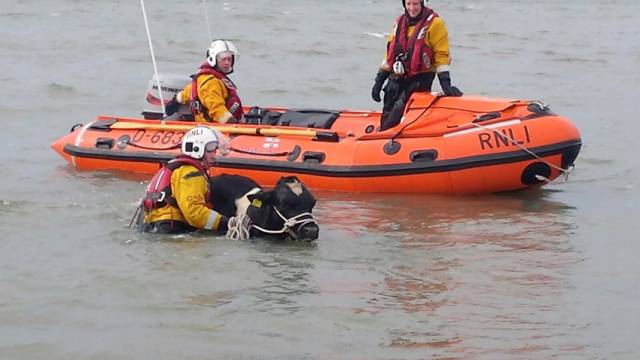#RNLI - In an unusual callout for Fethard RNLI recently, the volunteer lifeboat crew came to the aid of two bulls that had fallen from cliffs in the Broomhill area.
In difficult conditions, with an incoming tide and a large sea swell, the two animals in distress were brought to safety by the incredible efforts of the lifeboat crew on the day.
Fethard RNLI was already out on exercise with their neighbours in Kilmore Quay RNLI on Friday 24 February when the lifeboat was tasked to the Broomhill area at Waterford Harbour to a report of two bulls that had fallen from a cliff.
On scene at Broomhill by 11.20am, the lifeboat crew assessed each animal and decided to attempt a rescue as one was stranded in the gully with the incoming tide.
The second animal was 10 feet above the water on rocks further north and was relatively safe at that time.
The helm veered the lifeboat down into the gully and crew member Eoin Bird entered the water with a rope, swimming 50 yards in dangerous and difficult conditions to reach the stranded animal that had fallen some 15 metres.
Bird made a halter and placed it around the animal, then swam back to the lifeboat, which then towed the animal clear of the rocks.
The bull was brought alongside the lifeboat and one of the crew held its head safely above water for the 1.5km journey to Templetown Bay, where it was safely landed ashore to be taken into the care of the owner.
The lifeboat crew then returned to the scene where a halter and rope had already been placed on the second animal, which was then towed off the rocks and brought ashore.
Commenting on the callout, Fethard RNLI deputy launching authority Hugh Burke said: “This was a rescue with a difference for our volunteers, but we do train for every type of scenario. Nobody wants to see animals in distress or difficulty and we are happy to launch to bring them to safety.
“Conditions on the day were fairly lively with a two metre swell. The rescue involved excellent boat handling by our lifeboat helm John Colfer and great work by Eoin and Finola to bring the two animals to safety. It was one we won’t forget in a hurry.”
The lifeboat crew on this callout were helm John Colfer and crew members Eoin Bird and Finola Foley. Shore crew were Thomas Nolan and Tim Bradley.
































































